2016 Annual Report for OW14-040
Interior Alaska Hay Field Renovation Project
Summary
2016 was a busy year for the Interior Alaska Hay Field Renovation Project. Year 2 of plot treatments were implemented, plots were monitored throughout the summer and biomass, percent cover, forage quality and infiltration data were collected. The farmer survey and other outreach was conducted. Data was entered and we conducted preliminary statistical analyses to assess the effect of treatments on yield of forage and weedy species.
Objectives/Performance Targets
Farmer Survey:
In late winter of 2016, FSWCD completed the farmer survey about hay farming methods. Approximately a dozen local farmers were given a phone call to participate in the survey. Six farmers completed the survey. It should be noted that there are a limited number of hay farmers in Interior Alaska, so this is actually a fairly representative sample size. Farmers were asked questions about their farming methods and field renovation practices. Many had questions about conservation planning, soil testing, nutrient management, weed control, and other related subjects that we were able to assist them with. The farmers, on average, have had their hay fields in production for 21 years with no renovation. All of the farmers contacted were interested in renovating their fields but were hesitant to due to lack of information and the economic burden of renovating.
Outreach:
Personal contacts were made with local farmers through the farmer survey. Displays were showcased at local events including the Alaska SARE Conference, the Alaska Farm Bureau Meeting, and the Tanana Valley State Fair.
Spring Preparation for Field Season:
A seasonal technician was hired and trained to assist with the project. The participating farmers were contacted and we discussed our plans for the summer and what their involvement would be. In early summer, plot corners were found and marked with wire flags (different color flagging signified different treatments).
Field Season Objectives Met:
With assistance from the farmers, tillage radishes were overseeded in the Radish x2 plots and brome was overseeded in the Broadcast Radish plots. Between farms the overseeder was thoroughly cleaned with a power-washer to prevent the spread of weeds. FSWCD provided oversight of plot fertilization to ensure that it was done evenly and at an appropriate rate by the farmers. Germination rates of radishes were estimated. We estimated (from sample plots) that there were 13,125 radishes per acre for both Jenny M Farms and Davies Farm. Wild Iris Ranch had a much lower germination rate, at 3,281 radishes per acre. This could have been due to soil conditions such as low soil moisture.
Throughout the summer, all plots were monitored and photographed. In early July, we checked on the plots at Davies Farm and found that invasive weeds were getting out of control in some of the plots. The decision was made to mow all plots except for the overseeded radish ones for purposes of weed control. For this reason, we were not able to collect forage sampling data at this farm.
In August, point intercept forage sampling, soil infiltration measurements, forage rings, and forage quality sampling was done in each plot.
- 1 soil infiltration test was conducted per plot following the NRCS soil quality methods for soil infiltration using a 6 inch diameter metal ring.
- 3 forage rings were thrown randomly per plot. Vegetation in each ring was cut and bagged according to whether it was (a) hay, (b) weeds, (c) weedy grass, or (d) radish. Wet weights were obtained on each bag and then dried and weighed for a dry weight on each.
- 1 forage sample was collected per plot and these were sent to Brookside Laboratories for analysis.
- In each plot, data was collected along 3 line-point intercept transects. A tape measure was laid out across the middle of the plot parallel to the long edge of the plot. Transects were laid out at 3 random distances and random directions (using a compass) within the plot, centered on the tape measure. Transects were 20 feet long and data was collected every foot. At each data collection point, a wire flag was dropped and we recorded every plant species category that it intercepted. Categories included hay grass (G), weedy grass (WG), weeds (W), and radish (R). The first plant intercepted was recorded as the Top Canopy. Lower canopy layers were recorded in order of interception.
In the Fall FSWCD conducted lab analyses, data entry and quality checking of data. Preliminary statistical analyses are currently being conducted to assess treatment effects on yield of forage species, soil infiltration rates, and percent cover of forage species, and will be completed this spring.
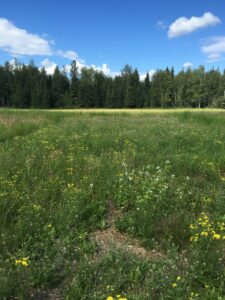
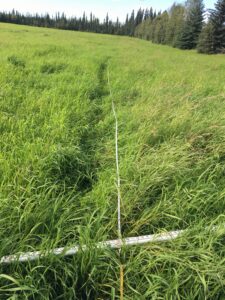
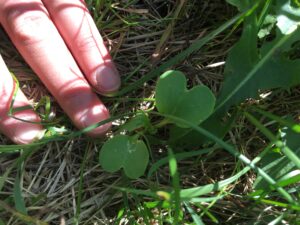
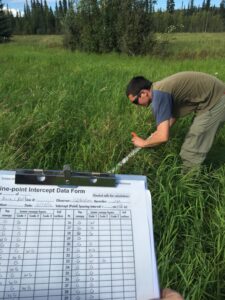
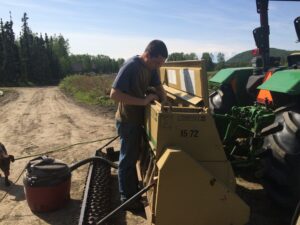
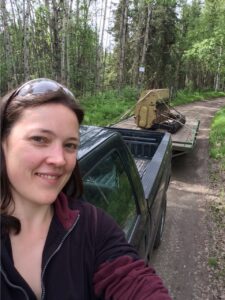
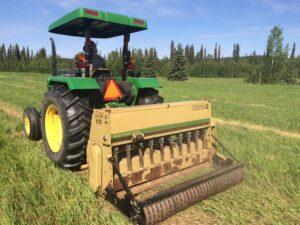
Accomplishments/Milestones
This year, FSWCD and the participating farmers completed the last of the necessary plot treatments, using the overseeder to plant radishes and to reseed the ‘broadcast radish’ plots with brome hay. Timing the plot treatments was challenging due to weather, farmers’ schedules, and soil moisture conditions, but it was successfully accomplished! The remaining work of soil and forage data collection will be very easy in comparison.
During fall and winter, FSWCD began analysis of the preliminary soil and forage data to evaluate the effect of the plot treatments. A two-way ANOVA with treatment and block as fixed effects revealed that none of the treatments had a significant effect on biomass of hay or weedy species on Jenny M Farm. On Tomsha’s farm there was a significant effect of block on the biomass of brome and weedy species. This result is consistent with the observation that one of the three blocks had very different soil characteristics and vegetation cover compared to the other two blocks. Analysis of treatment effects on soil infiltration rates and percent cover of forage species will be completed in the spring.
Although we could not detect any treatment effects on yield (biomass) of forage species, we have gleaned some very useful information from this study. Some of the observations we have made include:
- Radishes have difficulty thriving when seeded into existing hay stands. They typically get outcompeted by the grass and many remain stunted or end up dying.
- Treating hay and weeds with an herbicide before seeding radishes allows the radishes to germinate and thrive. We saw rapid growth of radishes in these treatment plots, with many obtaining heights of 5 feet and with root size of 1-6 inches and depth of 3-8 inches. It was impressive how well the radishes did without any seedbed preparation such as tillage.
- Successfulness of revegetation with brome hay after growing radishes for a season is very dependent on the weed seedbed of a field. Fields with a history of invasive plant issues do not revegetate well to brome and weeds can become a bigger problem. Fields with low weed presence revegetate very well to brome hay.
- While we did not see a significant change in brome hay cover when the overseeder was used to seed brome into existing stands, we anecdotally observed that field edges or other areas where brome was very sparse had increased brome percent cover after seeding with the overseeder.
It should be noted that these observations are based on our experiences at 3 local farms and might not hold true if the experiment was repeated at other farms with different environmental factors.
2016 Preliminary Percent Cover and Biomass Charts
Impacts and Contributions/Outcomes
The participating farmers, particularly Mr. Tomsha, Mr. Scharfenberg, and Mr. Davies, have contributed a large amount of time and resources during their already-busy summer to assist with the implementation of this study! Their efforts have been absolutely essential to the completion of necessary project work.
Through both word-of-mouth and through outreach activities, local farmers have learned about this project and have also learned about conservation practices that can be implemented on their own farms.
Collaborators:
Alpenglow Farm
PO Box 908
Delta Junction, AK 99737
Office Phone: 9074608628
Farm Manager
Large Animal Research Station
P.O. Box 756980
Fairbanks, AK 99775-6980
Office Phone: 9074745724
Website: http://lars.uaf.edu/